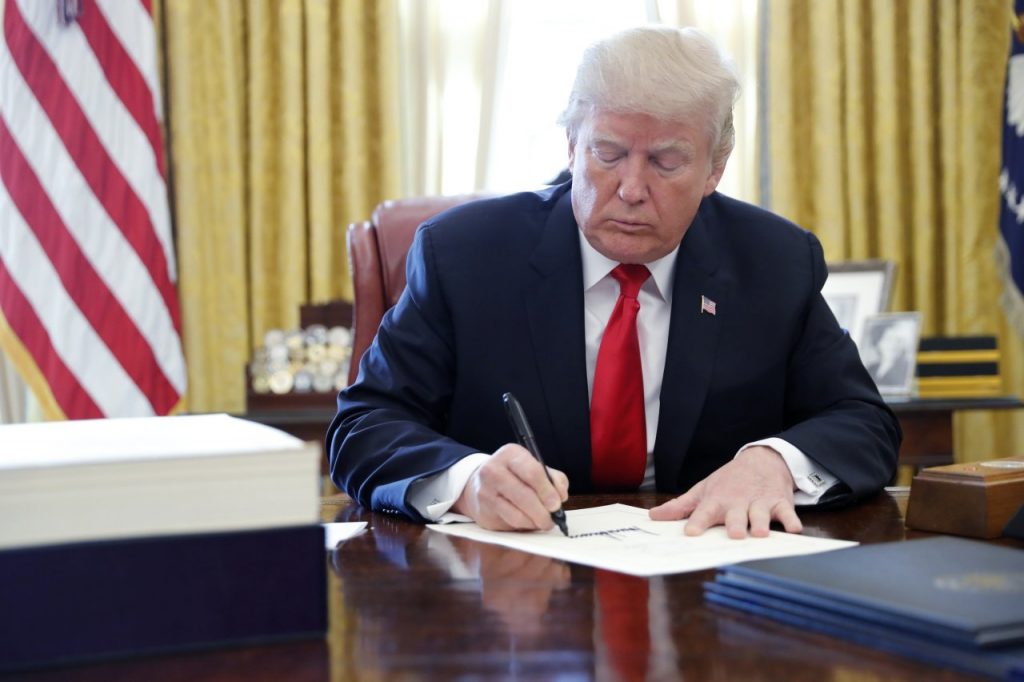President Donlad Trump on Friday signed a short-term spending bill to re-open the government, ending the longest partial federal government shutdown in U.S. history.
Trump signed the stop-gap spending bill just hours after the measure passed the Senate and House, respectively.
The second shutdown began on December 22, 2018, and became the longest in US history on January 12, 2019 surpassing the 21-day shutdown of 1995–1996 after failed attempts by Trump administration to reach a truce with Democrats on the funding of US-Mexico border- closure of the border being one of the electioneering campaign promises of Trump.
“On Friday, Jan. 25, 2019, the president signed into law: H.J. Res. 28, the ‘Further Additional Continuing Appropriations Act, 2019,’ which includes a short-term continuing resolution that provides fiscal year 2019 appropriations through Feb. 15, 2019, for continuing projects and activities of the Federal Government included in the remaining seven appropriations bills,” the White House said in a statement late Friday.
“Also included in the enrolled bill are provisions regarding retroactive pay and reimbursement, and extensions of certain authorities.”
Despite an end to the 35-day partial government shutdown, Trump on Friday night felt the need to defend the move, insisting that he had not caved on his sought-after funding for border security.
The deal for a short-term spending bill, which would keep the government open until Feb. 15, was agreed on to help those affected by the partial shutdown, the president said in a tweet.
I wish people would read or listen to my words on the Border Wall. This was in no way a concession. It was taking care of millions of people who were getting badly hurt by the Shutdown with the understanding that in 21 days, if no deal is done, it’s off to the races!
“I wish people would read or listen to my words on the Border Wall,” Trump tweeted. “This was in no way a concession. It was taking care of millions of people who were getting badly hurt by the Shutdown with the understanding that in 21 days, if no deal is done, it’s off to the races!”
Trump came to an agreement with Democrats to support a measure to re-open the government and, separately, negotiate a plan for border security. The deal does not include funding for a wall or barrier along the border, but the president said he was confident negotiations would continue to come to an agreement on wall funding.
After the deal was announced, the president was criticised by some for appearing to have given in to Democrats.
Conservative commentator Ann Coulter tweeted: “Good news for George Herbert Walker Bush: As of today, he is no longer the biggest wimp ever to serve as President of the United States.”
However, public disapproval of President Trump swelled five points to 58 percent over three months as a majority of Americans continue to hold him and congressional Republicans most responsible for the partial federal government shutdown that ended Friday, according to a new Washington Post-ABC News poll.
In addition, more than 1 in 5 Americans say they were personally inconvenienced by the record-long shutdown, which ended after lawmakers and the White House reached agreement on a three-week continuing resolution to reopen government agencies that had been shuttered for 35 days.
The deal left Trump without a victory in his battle for a border wall but also provided him a chance to keep fighting. Congressional leaders agreed to try to resolve the spending fight over border security in a conference between the Republican-led Senate and Democrat-led House before the continuing resolution expires.
Democratic leaders, including Pelosi, have called the wall “immoral.” They initially offered Trump $1.3 billion in additional border security resources that would not include a barrier — the same amount of funding the Department of Homeland Security received for border security in fiscal 2018. Democrats have proposed raising that amount as long as the money does not go toward a wall.
“If we are going to put money in border security, we should put it into technology, more of the infrared and underground sensors, because they work better than a wall,” said Ramiro Cavazos, president of the U.S. Hispanic Chamber of Commerce, who was among a group of Latino leaders who met with White House senior adviser Jared Kushner on Thursday to discuss the shutdown negotiations. “We’re not in favor of a wall.”
(Fox News)

